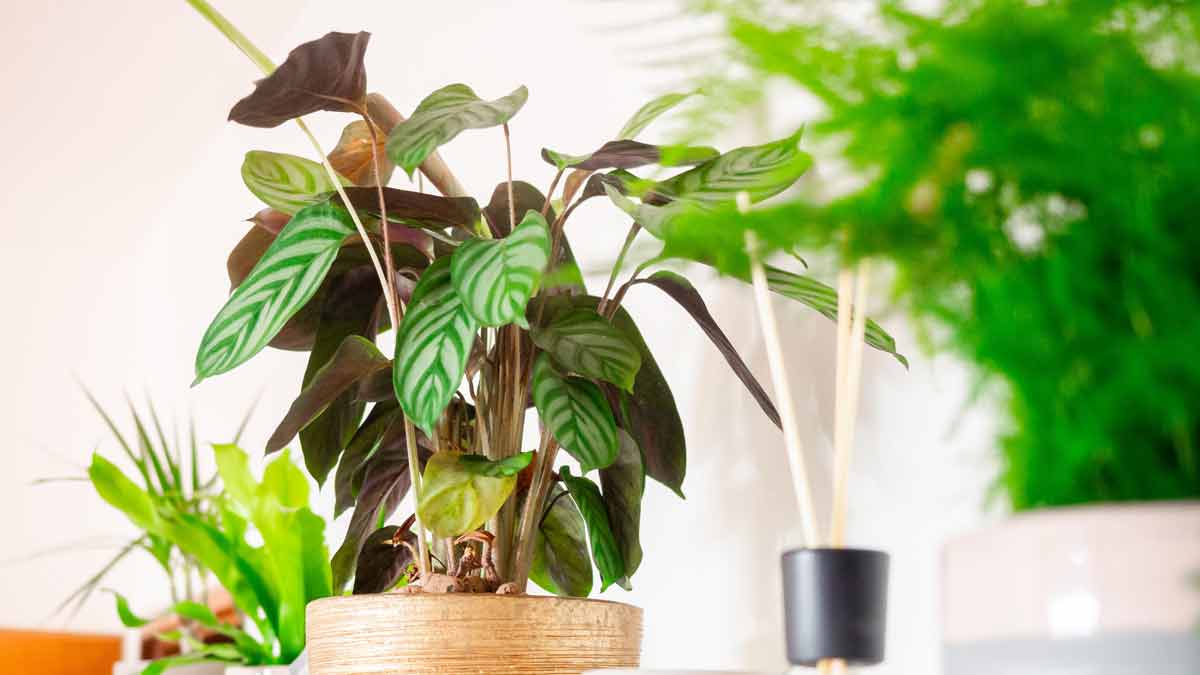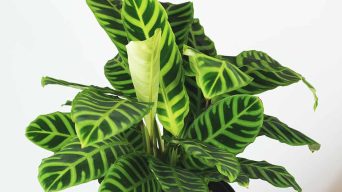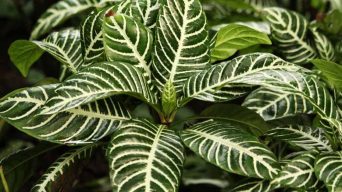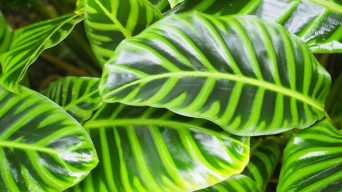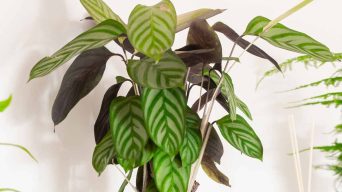Key Takeaways
- Zebra plants are visually striking tropical houseplants with dark green leaves adorned with bright white veins, resembling the pattern of a zebra.
- To care for indoor zebra plants, provide indirect or diffused light and consistent moisture in well-draining soil. You should also maintain moderate temperatures between 60-75ºF (15-23 ºC) and humidity levels between 60-70%.
- Common pests and diseases affecting zebra plants include aphids, mealybugs, spider mites, scale insects, root rot, stem rot, and leaf spots. Prevention is key to managing these issues.
- Proper care practices such as appropriate fertilizing techniques (using balanced fertilizer blends), selecting suitable containers for planting (with proper drainage), monitoring moisture levels regularly, and providing adequate lighting conditions can ensure healthy growth throughout the year.
Indoor gardening enthusiasts know that finding the perfect houseplant can be a rewarding challenge, and the Zebra plant is no exception.
With its striking dark green leaves adorned with vibrant white veins, this tropical beauty (Aphelandra squarrosa) brings an exotic touch to any space.
This guide will explore tips, tricks, and essential care requirements for maintaining healthy indoor zebra plants.
Understanding Zebra Plants
The indoor zebra plant, scientifically known as Aphelandra squarrosa, is a visually striking tropical plant with distinct features that make it an excellent addition to any living space.
Its bold foliage displays dark green leaves with bright white or yellow stripes resembling a zebra pattern.
Apart from its eye-catching foliage, one can expect stunning spikes of tubular yellow flowers adorned with unique bracts during the blooming season – typically between late spring and mid-summer.
These characteristics not only serve as conversation pieces but also play a role in enhancing the overall aesthetic appeal and ambiance of your home or office.
Benefits Of Having A Zebra Plant Indoors
Adding a zebra plant to your indoor garden has many benefits that can enhance your home’s aesthetics and atmosphere.
Known for its striking dark green leaves adorned with bright white veins, the Aphelandra squarrosa is an excellent choice as it not only adds visual interest to any room but also helps improve air quality.
Another advantage of having a zebra plant indoors is that it serves as an outstanding conversation starter due to its unique appearance.
Its beautiful foliage and vibrant yellow flowers during the blooming season set this houseplant apart, making it a fascinating focal point within your living space.
Furthermore, caring for a zebra plant promotes mindfulness and relaxation among owners, allowing them to develop good habits like routine watering and misting while ensuring their beloved houseplant thrives in optimal conditions.
Zebra Plant Indoor Care Guide
Learn how to properly care for your zebra plant indoors – from optimal lighting conditions to appropriate fertilizing techniques!
Proper Lighting Conditions
Zebra plants, known for their striking foliage, thrive in indirect or diffused light and can even tolerate some shade.
However, to promote flowering, it is ideal to provide them with bright indirect light.
Keep your zebra plant away from direct sunlight to prevent scorching its leaves – especially during summertime when the sun’s rays are most intense.
Insufficient lighting can lead to slower growth and leggy stems while also causing a decrease in purple coloring on the leaves.
To ensure proper lighting conditions for your zebra plant, consider placing it near a north-facing window or where it receives dappled sunlight throughout the day.
Adequate Watering
Adequate watering is crucial for the health and well-being of your zebra plant.
These plants prefer consistently moist soil, but overwatering can cause the leaves to wilt, turn yellow or brown, and even lead to root rot.
To ensure proper watering practices for your indoor zebra plant, keep up moist soil throughout the growing season by watering regularly (at least once a week).
However, be sure not to saturate the soil with water every time you water, as this may lead to excess moisture, which could harm your plant.
Saturating the soil once every few weeks with lukewarm water is recommended for optimal growth and development.
Soil Preferences
The zebra plant prefers well-draining, neutral soil to slightly acidic, with a pH range of 6.0-6.5.
Multi-purpose potting blends are suitable for this tropical plant and can be mixed with perlite or coarse sand to enhance drainage.
It’s important to check the soil moisture regularly and water only when the top inch of the soil feels dry.
Overwatering your zebra plant can lead to root rot, damaging or killing it.
Optimal Temperature And Humidity
The zebra plant is a tropical houseplant that thrives in moderate temperatures ranging from 60-75 ºF (15-23 ºC).
Temperatures above 55 degrees F (13 C) are necessary for the plant’s survival, while temperatures around 70 degrees F (21 C) are ideal for optimal growth.
It’s important to note that the zebra plant prefers a humidity level of 60-70%, with leaf edges browning and new leaves not developing correctly in lower humidity environments.
You can mist the plant regularly or use a humidifier to maintain proper humidity levels.
Placing a shallow tray filled with water near your zebra plant can also increase moisture in the surrounding air.
Appropriate Fertilizing Techniques
Fertilizing zebra plants is crucial for their growth and flowering.
Here are some appropriate fertilizing techniques to keep in mind:
- Use a balanced fertilizer blend that contains equal amounts of nitrogen, phosphorus, and potassium.
- Dilute the fertilizer according to the manufacturer’s instructions before application.
- Fertilize your zebra plant only during its growing season (spring and summer).
- Avoid fertilizing during winter, as it can harm your plant.
- Use water-soluble fertilizers formulated for flowers and foliage.
- Apply the fertilizer every other week during the growing season.
- Use a general-purpose water-soluble fertilizer once a month while the plant grows and blooms.
Choosing The Right Container
Selecting the right container is crucial for growing zebra plants indoors.
The ideal pot must provide ample root space, proper drainage, and good airflow.
Opt for a ceramic or terra cotta container at least 6 inches in diameter with several holes at the bottom to permit water drainage.
Also, consider using saucers under the pots, as they can catch excess water during watering sessions and prevent water damage to surfaces.
Be aware of overwatering because wet soil conditions could cause root rot, which is detrimental to your zebra plant’s growth.
Troubleshooting Common Issues
Learn how to identify and address common problems with your zebra plant, including leaf browning, spotting, drooping leaves, overwatering, underwatering, and pest infestations.
Proper diagnosis and action are key to resolving these issues.
Common Pests And Diseases
The zebra plant is a beautiful tropical houseplant, but it can be susceptible to various pests and diseases impacting its growth and health.
Here are some of the most common pests and diseases you should look out for:
- Aphids – These tiny insects feed on the plant’s sap and can cause yellowing leaves, stunted growth, and distorted foliage.
- Mealybugs – These white, cottony pests also feed on the plant’s sap and can cause leaf drop and stunted growth.
- Spider Mites – These tiny arachnids can cause webbing on the plant’s leaves, yellowing, and leaf drop.
- Scale – These insects typically appear as small bumps on the stems or leaves of the plant and can weaken it over time.
- Thrips – These tiny flying insects can cause curling or distorted leaves, silver streaks on foliage, and a mottled appearance.
As for diseases, here are some common ones that may affect your zebra plant:
- Botrytis Blight – This fungal disease causes brown spots on leaves or flowers and rotting stems or roots.
- Leaf Spots – This bacterial or fungal disease causes brown spots with yellow halos on the plant leaves.
- Stem Rot – This fungal disease causes wilting of stems, leading to eventual death if left untreated.
- Root Rot – Overwatering or waterlogged soil can lead to this fungal disease that damages roots and ultimately kills the plant.
Prevention is key when dealing with these pests and diseases in your zebra plant.
Leaf Browning And Spotting
One common issue many Zebra plant owners encounter is leaf browning and spotting.
Several factors, such as watering issues, lighting, and temperature problems, can cause this.
Brown leaf tips can occur due to drought stress caused by excessive transpiration or underwatering.
On the other hand, overwatering can lead to a collapsed stem and yellowing leaves.
Finding the proper moisture balance for your Zebra plant is important – keeping the soil moist but not overly saturated.
Also, leaf discoloration, like yellow or brown leaves, may signify improper lighting or humidity levels in your plant’s environment.
Solving Drooping Leaves
If you notice your Zebra plant leaves drooping, it could be due to overwatering or underwatering.
Here are some steps to solve this issue:
- Check the Soil Moisture: Use a moisture meter or stick your finger into the topsoil to check for moisture levels. If the soil is too wet, stop watering and allow it to dry before watering again.
- Adjust Watering Frequency: Zebra plants prefer moist soil but not wet soil. If you’re watering too frequently, reduce the frequency and amount of water given and regularly monitor the soil’s moisture level.
- Improve Drainage: Poor drainage can cause waterlogging in the soil and lead to drooping leaves. Ensure enough drainage holes are in the pot, and use a well-draining potting mix.
- Provide Proper Lighting: Lack of adequate light can cause drooping leaves in Zebra Plants. Place your plant near a well-lit window where it can receive bright indirect sunlight.
- Address Pest Issues: Some pests, like mealybugs or spider mites, can attack your Zebra Plant, causing stress that may result in drooping leaves. Address these issues by using insecticidal soap or neem oil.
Overwatering And Underwatering Management
Zebra plants are sensitive to both over and underwatering, making them tricky to maintain.
Here are some tips for properly managing your watering routine:
- Check the soil moisture regularly using a moisture meter or stick your finger in the soil up to the second knuckle—only water when it feels dry.
- Water thoroughly, ensuring water runs out of the drainage holes at the bottom of the pot.
- Avoid letting your zebra plant sit in standing water, leading to root rot.
- During the active growing season, consistently moist soil is preferred, but overwatering can cause the leaves to wilt and eventually drop off.
- If you suspect overwatering is a problem, let the soil dry out completely before watering again.
- Poor drainage and repeated overwatering are the most likely culprits of a rot problem.
- Underwatering can also cause leaf wilting and eventual drop off. As soon as you notice signs of dehydration (like drooping leaves), water the plant immediately with room temperature water until it drains from the bottom of the pot.
- To prevent underwatering in hot or dry conditions, consider using a humidity tray or regularly misting your zebra plant’s foliage.
Maintaining an Indoor Zebra Plant
Ensuring the health and prosperity of your zebra plant requires regular upkeep, such as repotting, cleaning, pruning, pinching, and providing support when needed.
Repotting When Necessary
If you notice that your zebra plant has become pot-bound or has outgrown its current container, it may be time to repot.
Here are some essential tips to follow during the repotting process:
- Choose a pot that is only one size bigger than the current pot. This will prevent over-potting and ensure the plant’s roots have enough space for growth.
- Use a well-draining potting mix to prevent waterlogged soil and root rot.
- Gently remove the zebra plant from its current pot, careful not to damage the roots.
- Check the roots for any signs of damage or disease and trim them if necessary.
- Place some fresh soil in the bottom of the new pot and position the zebra plant in the center.
- Fill around the edges with fresh soil, ensuring not to bury any leaves or stems.
- Water thoroughly and keep in bright, indirect sunlight until it has re-established itself in its new home.
Remember that repotting is only necessary every two to three years, so don’t rush into it unless you notice clear signs that your zebra plant is struggling in its current container.
Cleaning And Maintenance Requirements
Cleaning and maintaining your indoor zebra plant is crucial to ensure its longevity and health.
Here are some simple steps to follow:
- Wipe the leaves regularly with a damp cloth to remove dust and debris. This helps prevent pests and fungal growth on the foliage.
- Trim off any yellow or brown leaves and stems using sterilized pruning shears. This promotes healthy growth and maintains the plant’s shape.
- Check the soil moisture levels regularly, and water only when the top inch of soil feels dry to the touch. Overwatering can lead to root rot, harming your zebra plant’s health.
- Clean any excess water in the drainage tray beneath your pot, as standing water can lead to fungal growth or attract pests.
- Repot your zebra plant every 2-3 years with fresh soil to provide new nutrients for healthy development.
Pruning And Pinching Techniques
Pruning and pinching are essential for maintaining your indoor Zebra plant’s overall health and growth.
Here are some techniques to follow:
- Use a clean, sharp pair of scissors or pruning shears to cut the stem just above a node where new growth can emerge.
- Pinch back the tips of your Zebra plant when it becomes too leggy or grows in an undesirable direction.
- After the bract dies, prune back both the stem and leaves to a pair of leaves at the base of the plant to encourage new growth.
- Prune off any damaged or unhealthy foliage using sterile equipment to avoid spreading diseases.
- When taking cuttings for propagation, ensure each cutting has at least two leaves and a stem section.
By following proper pruning and pinching techniques, you can promote denser foliage and healthier growth and prevent any potential health issues from arising with your indoor Zebra plant.
Providing Support For Your Zebra Plant
Aphelandra zebra plants can grow up to two feet tall and require support to keep them upright.
One way to provide support is by staking the stem with a thin, sturdy stick and securing it with soft twine or plant ties.
It’s important not to tie the stake or trellis too tightly around the stem of the zebra plant, as this can cause damage or restriction in growth.
As your zebra plant grows taller, adjust the stake or trellis placement accordingly and ensure it stays securely in place to avoid accidents.
Final Thoughts
Caring for indoor zebra plants may be challenging, but their lush foliage and striking appearance make them a fantastic addition to any plant lover’s collection.
Remember to keep an eye on lighting conditions, humidity levels, watering schedules, soil preferences, and fertilizing techniques to encourage healthy growth year-round.
With proper care and attention, your Aphelandra squarrosa will reward you with its stunning white-veined leaves for many years, making it an excellent investment for any home or office space.

